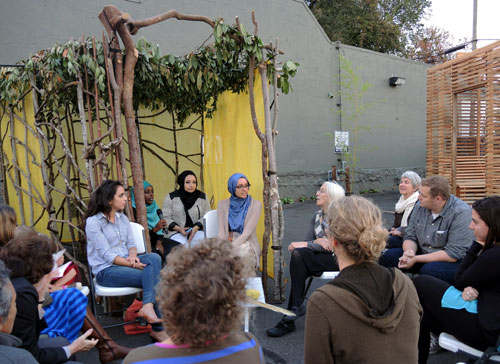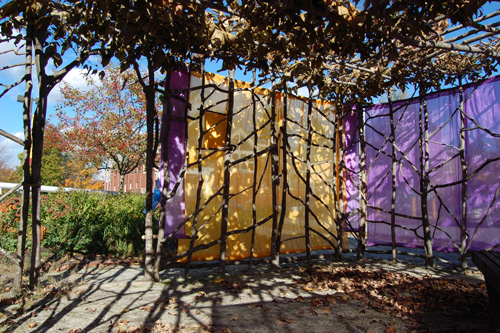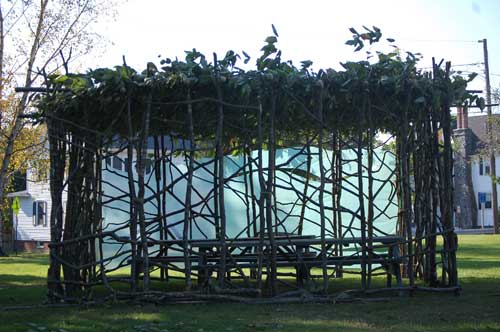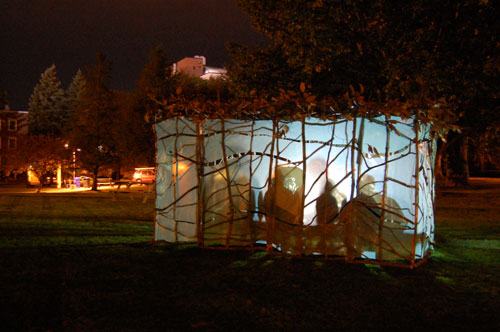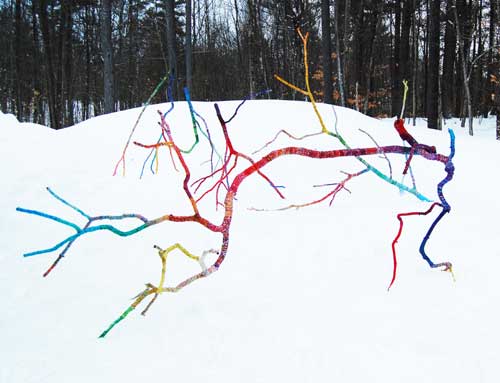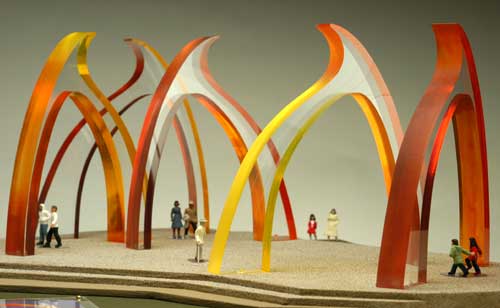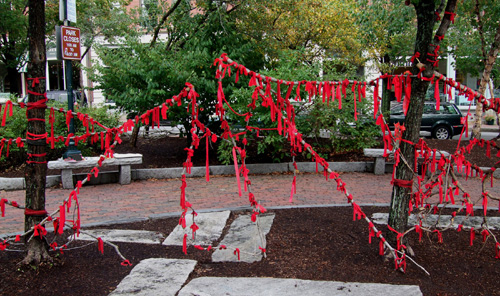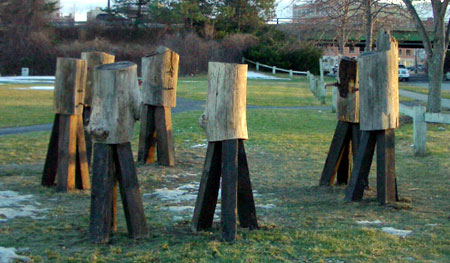My public art invites the viewer to actively engage with personal and public issues (to dialog about equality, relationships, environment, and global community). I aim to create sacred spaces, in which people can reconnect with themselves, each other, and the Earth. My work utilizes everything from intimate narrative to complex psychodrama and communal ritual.
Dwelling Place Update
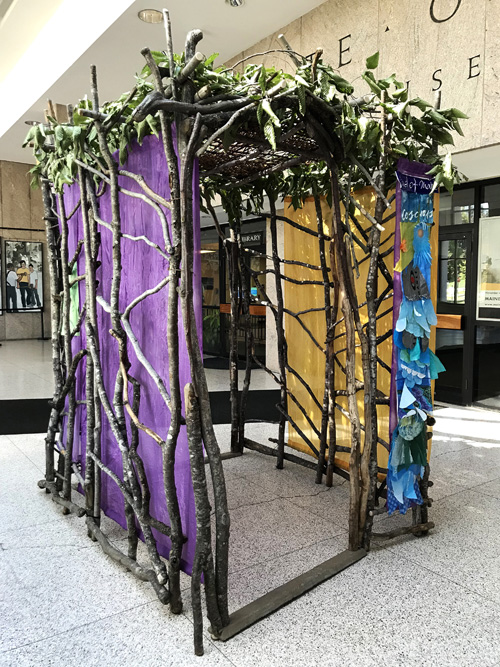
Dwelling Place: installation view (considerably scaled down and redesigned version of earlier work) in lobby of Maine State Museum. The selection of this piece recognized the role the original installation has played in Portland Jewish life over 7 years. It was redesigned and installed for one month in the Fall of 2018 as an introduction to the museum’s first ever exhibition on the history of Jews in Maine. More information about this installation.
Measurements: 9’H x 6’L x 5’W
Mixed locally harvested hardwoods and bark, hand dyed nylon fiber, stains
2018
Brief Sanctuary
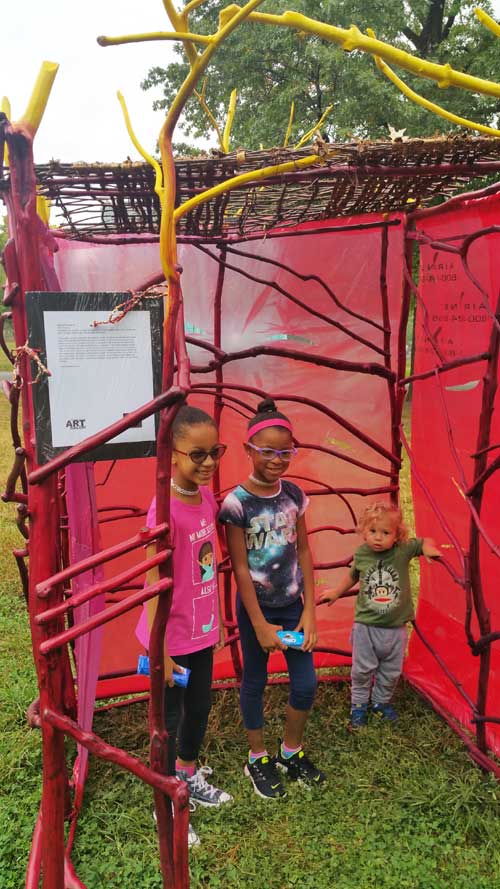
Installation at SukkahWood, New York
Measurements: 5″ L x 4.5′ D x 6.5′ H
sustainably harvested maple, apple, and ash wood, dye, recycled plastic, woven ash bark roof
2017
When Will We Have Time? – Khi năo chúng tăi cơ thời gian?
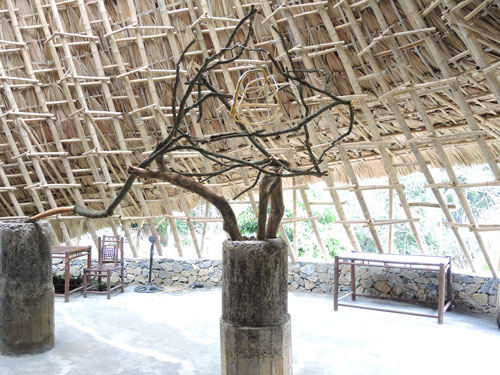
Installed at Muong Studios, Hoa Binh, Vietnam
When Will We Have Time?
Khi năo chúng tăi cơ thời gian?
Asherah Cinnamon, USA and Vương Lể Mỹ Học, Việtnam
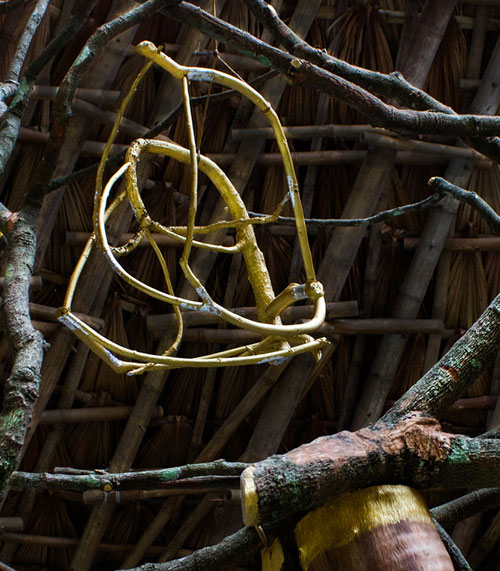
Approximately 14’L x 6’W x 10’H
Locally sourced mixed wood and silver leaf, gold acrylic paint
2015
Vương Lể Mỹ Học and Asherah Cinnamon
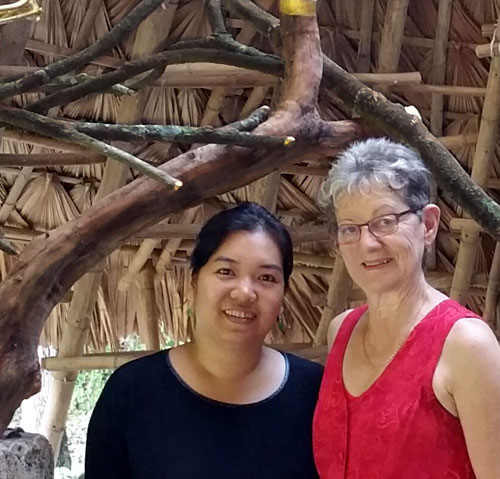
In discussing a possible collaboration with each other, TIME became the key artistic resource that each woman agreed was the most challenging, as well as most scarce and precious. Both artists have had to think and strategize about the use of their time as artists, mothers, and wives. While time is important and may be a struggle for all artists who have to earn their living, it is a specifically challenging for women artists. The two chimneys from which the installation emerges are cooking stove chimneys from a former kitchen on the floor below.
photos by Long Hoàng
Shema: Listen
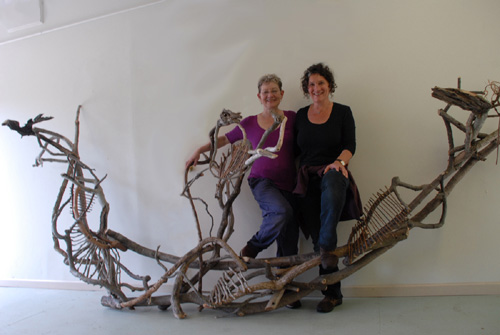
Based on the Hebrew letter shin, the first letter in several significant Hebrew words, and the first letter in the most important prayer in the Jewish religion, the Shema. Collaborative project with Australian artist, Nikki Green
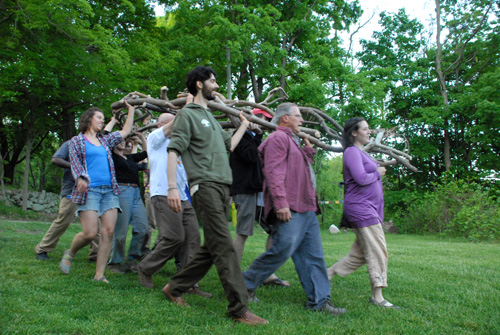
Art Kibbutz New York artist residency in 2013.
Created from wood found during the three weeks.
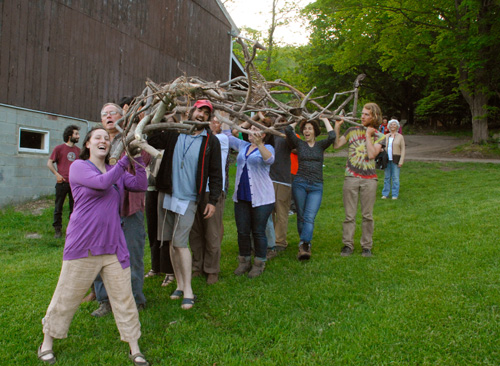
Carried from studio to lake in performance procession with music and song.
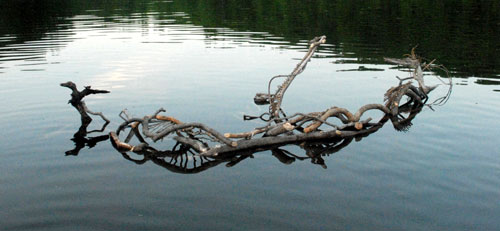
12′ L x 6′ W x 2.6′ H when floating
Installed in Eden Village lake, Putnam Valley, New York.
All project photos copyright Paul R Solomon 2013
Dwelling Place 2011 – 2017
2012 University of New England Gallery, Portland.
mixed local hardwoods, beech twigs with leaves attached, hand-dyed nylon
9′ H x variable size walls up to 14′ W x 15.5′ L
An installation to mark the Jewish Festival of Sukkot. Sponsored by Southern Maine Hillel and colleges and universities in the region. Funded in part by the 2011 Linda and Joel Abromson Award.
2011 University of Southern Maine
The goal of this project is to create space that is spiritually inspiring and personally healing. It is also an important community building opportunity.
A Sukkah must feel temporary, even fragile, yet be able to withstand a stiff wind. It must feel like shelter, at least spiritually. It must reconnect those who enter it to the natural world, themselves, and each other.
More photographs and history of the process and installation of this project.
For more information, here is the Portland Press Herald article.
Pay It Forward
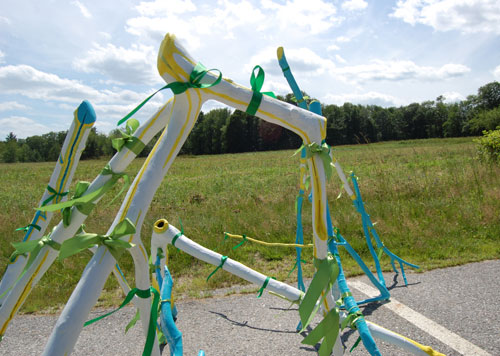
Pay It Forward: an interactive temporary public art installation at new offices of Modern Woodmen Of America, Standish, Maine. Part of a themed summer festival in the town.
2011 : mixed hardwoods, paint, ribbon size varies
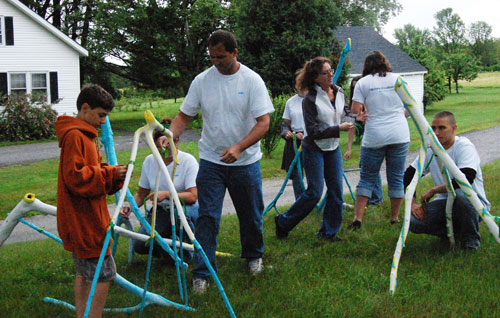
On site signage read:
“Pay It Forward >>>
Has someone ever done you a kindness?
Will you ‘pay it forward’ (do a kindness for a stranger) when you can?
Make a commitment here to pay it forward. Take a green ribbon. Gently tie it onto this sculpture. Make a promise to yourself. Make a better world – one kindness at a time.”
Friendship II
Friendship II: Installation and interactive recycling project, 6 pieces
2010 – 2011
hardwoods; recycled plastic bags, cut, braided, bound
20’L x 15′ W x 7’H, footprint varies
The project explores the concept of friendship in contemporary times. Using strips cut from brightly colored recycled plastic bags, the installation was inspired in part by the friendship bracelets used in many communities today.
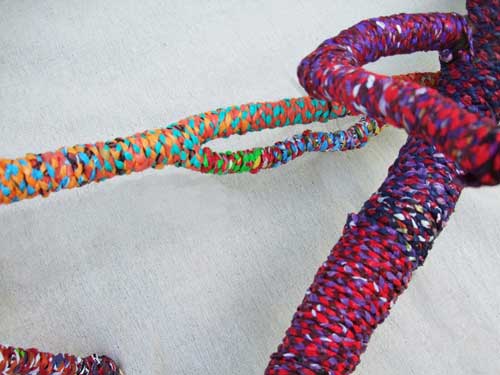
Friendship II: Materials detail
The Friendship series celebrates the traditional female practices of braiding, and of collaborating to develop a work of art larger than any one person might create. The project encourages creative recycling and invites groups of people to work together, exploring the role of friendship in contemporary life through handwork, discussion, and writing.
Friendship in Hard Times

University of New England Art Gallery 2010
Created with students from Fred P. Hall School Many Rivers Program, Baxter School for the Deaf and Hard of Hearing, Bonnie Eagle High School, and friends of the artist.
Materials: Mixed hardwoods and 1,000 feet of braids from over 300 recycled plastic bags. The traditional braided bracelets seem to have originated with Central American Indigenous cultures and simultaneously in several Asian societies, and have widely influenced recent popular youth culture in many locations, making friendship both tangible and visible as a strong value.
More photographs, participant-quotes and student writings about friendship.
2008 Olympics Landscape Sculpture Design

Dimensions: height: 8 meters (26 feet), width: variable by location
Materials: Architectural glass, steel infrastructure, internal lighting
As finalist in the International Olympic Landscape Sculpture Design Contest, this design by Asherah Cinnamon and Scott Fuller toured China and global capitals, including Shanghai, Paris, Barcelona, and Gisborne. It opened in Sacramento, moved from there to the United Nations, and was eventually placed in Tienanmen Square during the 2008 Olympics.
“Olympic Games are among the most humanly inspiring events in history. The Olympic flame is carried for long distances, passed from athlete to athlete, to call participants together from all over the world. By inviting visitors to walk under this sculpture we offer them the inspiration to be part of something larger than themselves, to reach for their own goals with courage, determination, and persistence.”
— Asherah Cinnamon and Scott Fuller
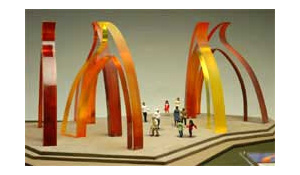
The gates themselves are visual reminders of the Chinese calligraphic characters for “people” and “enter”.
On a recent visit to China Asherah was inspired by its people and natural beauty. She has a deep respect and love for Chinese calligraphy and art history, and is especially inspired by Chinese contemporary art. Feeling that she owes her life and the life of her family to China, (biography), she is honored to be part of the 2008 Beijing Olympics. All design copyrights held by the Beijing Organizing Committee for the 2008 Olympic Games (BOCOG). Photographs by Jay York.
Teshuvah:Turn and Mend
Post Office Park, Portland, Maine
September 11 through 29, 2007
“Art in The Park”: Sponsored by Portland Department of Parks and Recreation in cooperation with the Maine College of Art
“I invite you, the Public, to mark a personal commitment to mend or make amends by gently tying a red ribbon onto this sculpture. Each ribbon represents a personal commitment to take positive initiative to strengthen a relationship in your life.”
—from the information sign at the site for Teshuvah
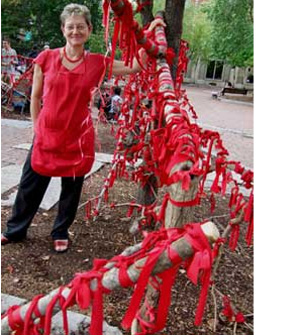
My inspiration for this installation has come from several sources in my heritage. I have interpreted the concept of Teshuvah in this work as an offer to everyone, of all beliefs, to symbolically take a moment of reflection, and an opportunity for action.
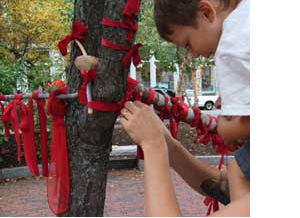
Teshuvah: A Jewish New Year tradition that means “turning”, changing direction, reaching for reconciliation and making or choosing new pathways in order to repair damaged relationships.
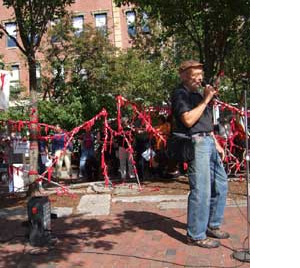
Rosh Hashannah: The New Year, or birthday of the world. It begins at sundown, usually in September. This day is the start of ten days of prayer and reconciliation, which end with Yom Kippur. During these ten days people are encouraged and even required to take positive initiative to mend relationships. According to tradition, if a person genuinely attempts three times to apologize and make amends in a relationship during these ten days, the person they hurt is required to listen and to seriously consider accepting the attempt at reconciliation. I worked on site for ten days prior to Yom Kippur of 2007, installing this work and providing ribbons for viewers, then for one week after Yom Kippur visited the site twice daily replenishing ribbons for the public and talking with people, when they wanted to do so.
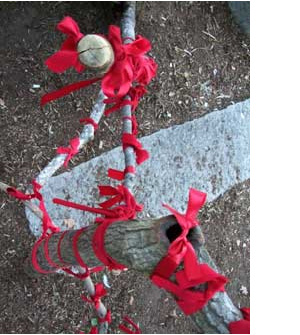
Note: The Jewish calendar differs from the one most people use in the western world. It is a moon based system, so Jewish holidays do not seem to fall on the “same day” each year.
More photographs and history of the process and installation of this project.
Kaddish for the Dispossessed
Objects found near railroad tracks, wood, steel, roofing tar
6.5′ high; approx. 15′ wide x 17′ long
Public Art Project located at Back Cove Green, Preble Street Extension, Portland, Maine
December 3, 2006 through March 25, 2007
Hosted by “Art In The Park”, City of Portland, Parks and Recreation, phone 207-756-8275
A Public Forum and Dialogue to Connect the Arts and Social Justice Communities in the Active Pursuit of Economic Justice to end Homelessness was organized by the artist in 2007 at the Institute for Contemporary Art, Maine College of Art. Panel moderator: Mary Ann Gleason, former Executive Director, National Coalition for the Homeless.
When people become homeless they are forced to live outdoors, often in the worst of weather. Even if they sleep in a shelter some nights, their days are spent outside. They make friends, argue, live, sometimes die, and often grieve in public places. This project is inspired by the community of people who have experienced homelessness, and by the tragedy of two friends, one killed in 2006, the other accused of causing his death. Most of the violence experienced by homeless people does not come from other homeless people. But if one person, driven to such circumstances, kills another, who will grieve for them both? Who among us, with warm private places to live, will ask how others have been brought to that situation in this country of such wealth? No one with real options would choose it.
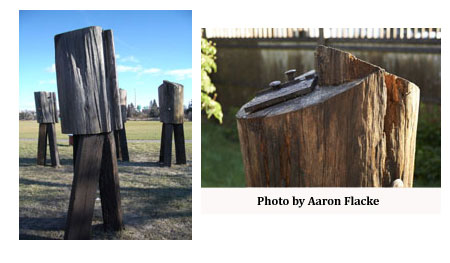
On any given night in Maine at least 3,000 women, men, and children are without a safe place to sleep. I want to call attention to the harsh reality of the lives of the people society discards and then blames for developing coping strategies of which we do not approve. I use the materials I found near the railroad tracks to honor the situation of two friends, who on their best days were part of a community that had pleasure in life and in each other.
The title of this project refers to the Jewish tradition of mourning, which requires the presence of a community of at least ten people to assist the grieving to say a special prayer when the death of a loved one occurs and to remember that life is still worth living. This prayer is called Kaddish. I intentionally did not place the required ten figures in the circle. I wanted to invite everyone who sees this work to feel that they have the opportunity and the invitation to get involved to complete the circle, so that together we can grieve and then take action to stop the economic injustice that leads to cycles of homelessness, addiction, and violence.
More photographs and history of the process and installation of this project.
For more information about homelessness and what you can do to help you can be in contact with Preble Street.
Healing from the Plague of War: Jewell Island Explorations
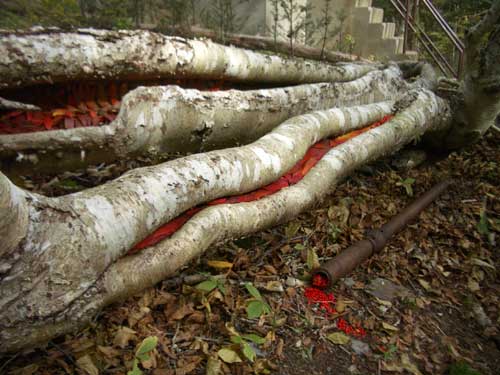
Healing from the Plague of War: 1
In fall of 2006 I spent a day on Jewell Island in Casco Bay, near Portland, Maine. The island was used as a military outpost during WWII and has been in disuse for decades. Many artifacts of the military occupation of the island have been succumbing to the elements in interesting and beautiful ways. My family was torn apart and many were murdered in Europe during that war. I am drawn to the idea of how humans can heal from war and other deep hurts, and to the images and metaphor of the Earth healing at the same time.
Photographs available for purchase, please contact the artist.
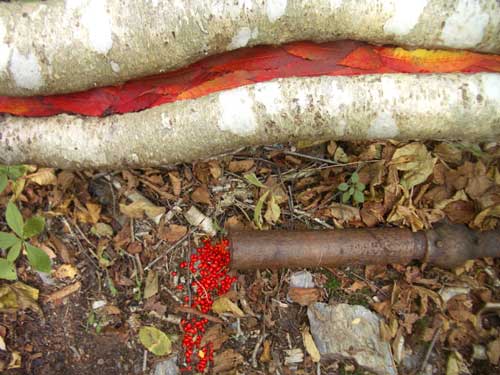
Healing from the Plague of War: 2
I was drawn to brilliant wild berries and leaves, which seemed to shout life, even as they were reminders of spilled blood. Two white birch trees, pulled over and split decades ago, lay next to a decaying military observation tower.
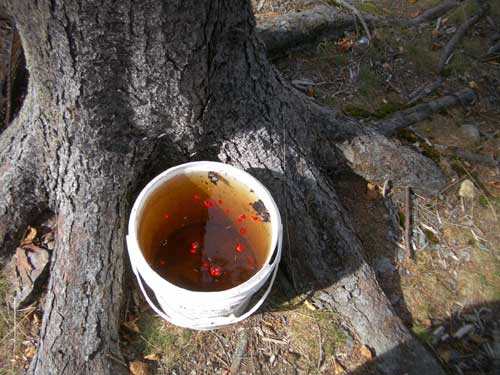
Healing from the Plague of War: 4
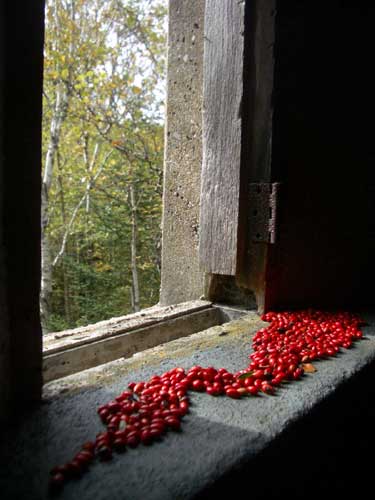
Healing from the Plague of War: 6

